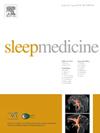Sleep risk factors modify the association between c-reactive protein and type 2 diabetes: A prospective cohort study
IF 3.8
2区 医学
Q1 CLINICAL NEUROLOGY
引用次数: 0
Abstract
Objective
To investigate the prospective association between serum CRP levels and T2D incidence and explore whether such association was modified by sleep risk factors.
Methods
The study included 366 746 participants without diabetes and exhibited CRP measures at baseline from the UK Biobank. Sleep risk factors included sleep duration, insomnia, snoring, chronotype, and daytime sleepiness. Cox proportional hazards model was used to estimate the hazard ratio (HR), and 95 % confidence interval (CI) of T2D associated with CRP levels. Interactions between CRP and sleep risk factors were also tested.
Results
During a median follow-up of 10.4 years, 14 200 T2D cases were identified. The HRs (95 % CIs) of T2D were 1.31 (1.21–1.43), 1.62 (1.50–1.75), 1.98 (1.83–2.13), and 2.38 (2.21–2.57), respectively, in higher quintile groups of CRP levels compared with the lowest group (p-value for trend <0.001). There were interactions of CRP levels with self-reported sleep duration, snoring, and daytime sleepiness (p-value for interaction = 0.002, 0.0002, and 0.0001). The associated risks between T2D and the elevation in CRP were more evident among participants with high-risk sleep factors.
Conclusions
Our study indicates that the elevation in serum CRP levels is associated with a higher T2D incidence; and such relation is modified by sleep risk factors including sleep duration, snoring, and daytime sleepiness.
睡眠风险因素会改变 c 反应蛋白与 2 型糖尿病之间的关系:一项前瞻性队列研究
目的研究血清CRP水平与T2D发病率之间的前瞻性关联,并探讨睡眠风险因素是否会改变这种关联:研究纳入了 366 746 名无糖尿病的参与者,他们的基线CRP指标均来自英国生物库。睡眠风险因素包括睡眠时间、失眠、打鼾、慢性型和白天嗜睡。Cox比例危险模型用于估算与CRP水平相关的T2D危险比(HR)和95%置信区间(CI)。此外,还测试了 CRP 与睡眠风险因素之间的交互作用:结果:在中位 10.4 年的随访期间,共发现 14 200 例 T2D 病例。与最低组相比,CRP 水平较高五分位数组的 T2D HRs(95 % CIs)分别为 1.31(1.21-1.43)、1.62(1.50-1.75)、1.98(1.83-2.13)和 2.38(2.21-2.57)(p 值为趋势结论):我们的研究表明,血清 CRP 水平的升高与 T2D 发病率的升高有关;而睡眠风险因素(包括睡眠时间、打鼾和白天嗜睡)会改变这种关系。
本文章由计算机程序翻译,如有差异,请以英文原文为准。
求助全文
约1分钟内获得全文
求助全文
来源期刊

Sleep medicine
医学-临床神经学
CiteScore
8.40
自引率
6.20%
发文量
1060
审稿时长
49 days
期刊介绍:
Sleep Medicine aims to be a journal no one involved in clinical sleep medicine can do without.
A journal primarily focussing on the human aspects of sleep, integrating the various disciplines that are involved in sleep medicine: neurology, clinical neurophysiology, internal medicine (particularly pulmonology and cardiology), psychology, psychiatry, sleep technology, pediatrics, neurosurgery, otorhinolaryngology, and dentistry.
The journal publishes the following types of articles: Reviews (also intended as a way to bridge the gap between basic sleep research and clinical relevance); Original Research Articles; Full-length articles; Brief communications; Controversies; Case reports; Letters to the Editor; Journal search and commentaries; Book reviews; Meeting announcements; Listing of relevant organisations plus web sites.
 求助内容:
求助内容: 应助结果提醒方式:
应助结果提醒方式:


